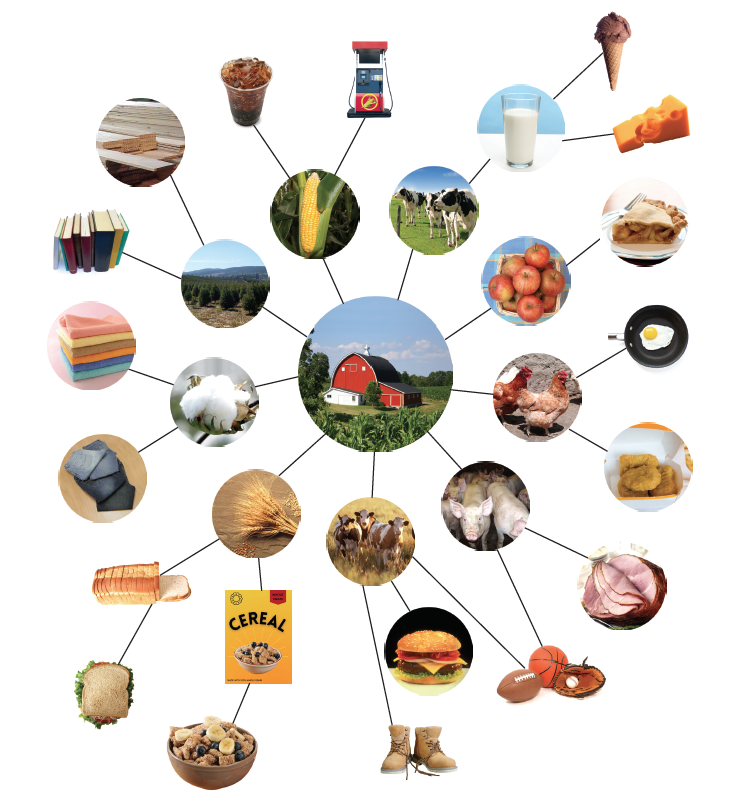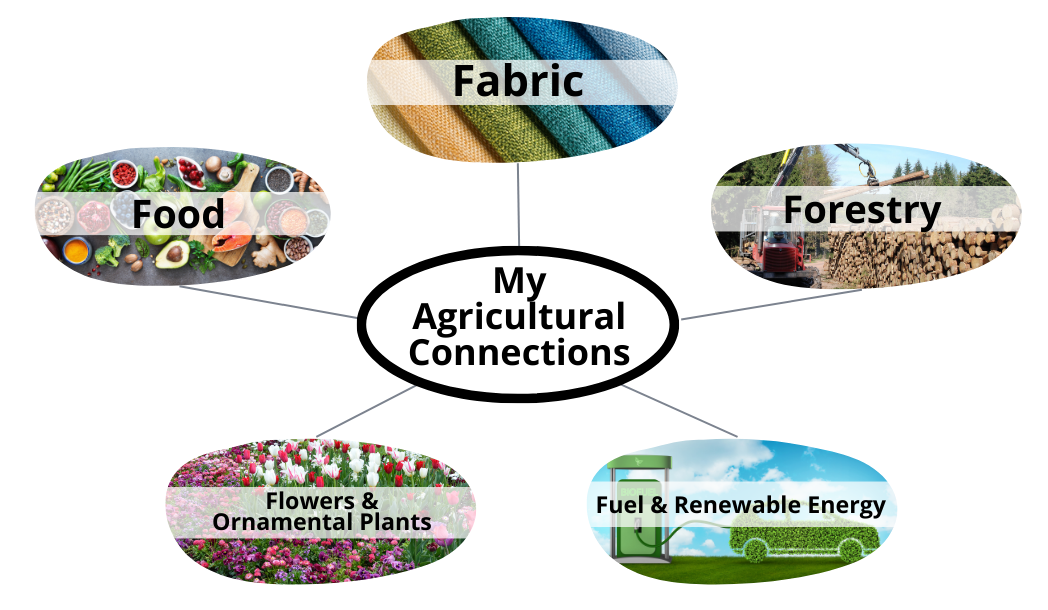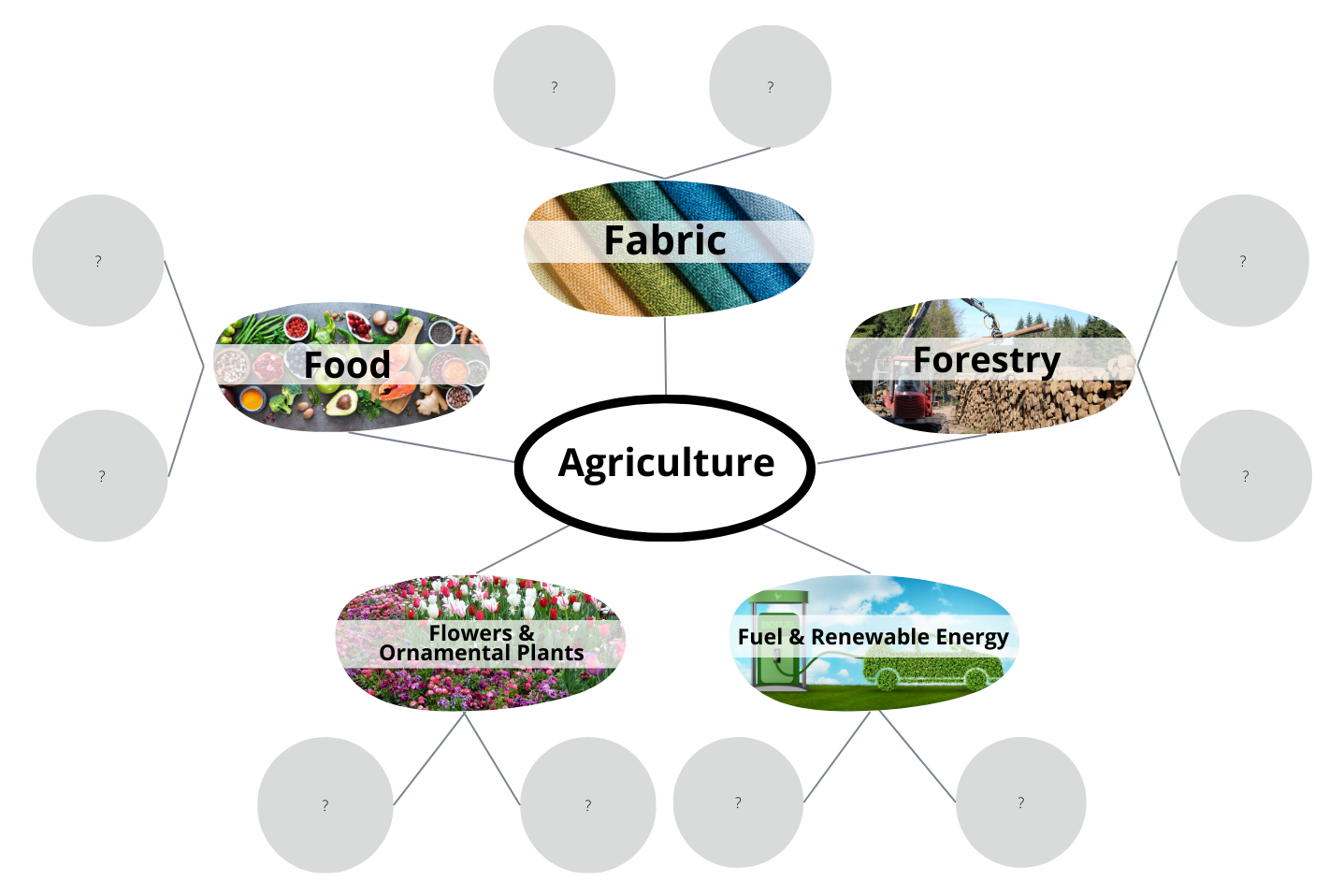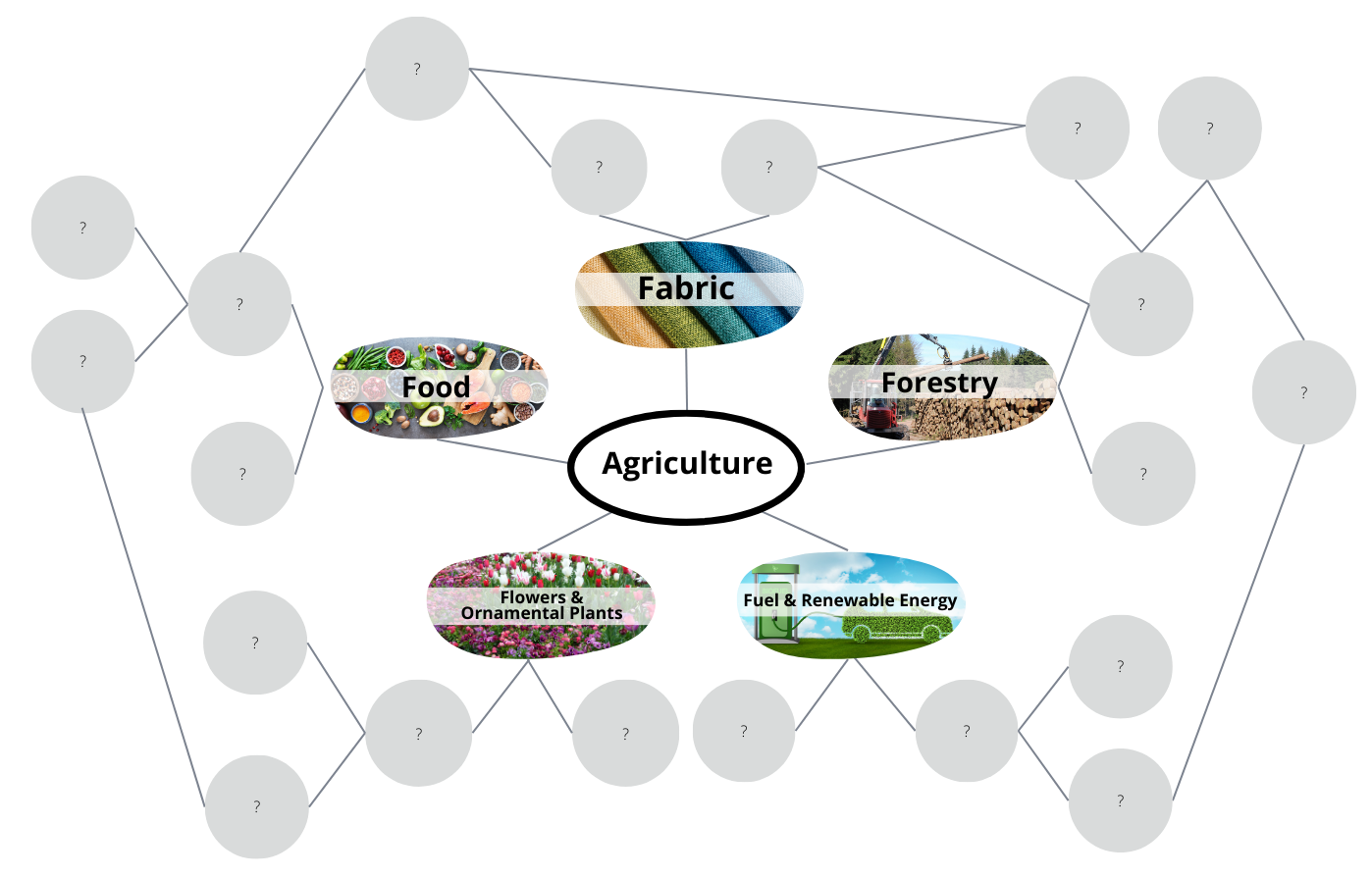Curriculum Matrix
Lesson Plan
My Agricultural Connections (Grades 9-12)
Grade Level
Purpose
Explore how we are each connected to agriculture through our food, clothing, shelter, fuel, and more. Students will be introduced to agriculture and begin to recognize the depth and complexities of agricultural systems locally and globally. Grades 9-12
Estimated Time
Materials Needed
Engage:
- Farm Web graphic
Activity 1: My Agricultural Connections
- Chart paper, butcher paper, or other large craft paper; five (5) total, one (1) per student group
- Markers appropriate for boldly writing on chart paper
- My Agricultural Connections sheets, one (1) copy per class
Activity 2: Making Deeper Agricultural Connections
- Mind map and markers used in Activity 1
- Making Deeper Agricultural Connections, five (5) copies
Activity 3: Connections to Agriculture All Around Me (Optional)
- Connections to Agriculture All Around Me handout, one (1) per student
- Device with internet access
Evaluation:
- Food System Maps to project on board (page 2)
Vocabulary
agriculture: the science or practice of farming, including cultivation of the soil for the growing of crops and the rearing of animals to provide food, wool, and other products
Did You Know?
- The average American eats about 68 quarts of popcorn each year.1
- Bananas are most likely the first fruit ever to be grown on a farm.2
- Americans cumulatively eat approximately 100 acres of pizza each day, or 350 slices per second!3
- Americans are eating 900% more broccoli than we did 20 years ago.4
Background Agricultural Connections
How do you define the word agriculture? The Merriam-Webster Dictionary states that it is the “science, art, or practice of cultivating the soil, producing crops, and raising livestock and in varying degrees the preparation and marketing of the resulting products.” An accurate definition, but this definition doesn’t impart the integral nature or importance of agricultural products—food, clothing, and shelter—in our daily lives. This seemingly simple definition represents a very complex system!
The milk for your cereal began on a dairy farm just a few days before your breakfast. The dairy farmer relies on veterinarians and animal nutritionists to keep their cattle healthy. The farm may grow their own cattle feed or purchase it from another farm. Employees of the farm care for the cows from calf to adult and milk the cows daily. Truckers haul the milk from the farm to a bottling plant where food scientists test the milk to be sure it is pure and healthy. The milk is homogenized, pasteurized, bottled, and boxed with the help of packaging engineers before it is shipped off to grocery distribution centers, finally making it to your local store and then to your breakfast table. All along the way people work to pay bills, buy and sell supplies, market and advertise the milk, build cooling systems, machinery, and packaging. Scientists investigate the health of dairy cows, the nutritional value and safety of the milk, and more. Grocery staff stock the dairy cases with the gallon jugs and help you bag your groceries. Each step of this farm-to-table process is subject to governmental regulations and is affected by the ups and downs of the global economy. Each step considers its impacts to the environment and must manage the effects of unpredictable weather (Milk Means More, 2018). The path milk takes from cow to cereal bowl is similar to that of many, many other agricultural products, most with many other processing steps to become the food, clothing, fuel, or building products we use every day.
From crops and livestock grown around the world to climate change, consumer buying preferences, food insecurity, international policy, and technological innovations, agriculture is a very complex topic. While high school students might recognize the ways agriculture provides directly for their food, clothing, and shelter, exploring some of these complexities will help prepare these young adults for making decisions or to prompt the further study of economics, science, or policy.
Lesson Pedagogy
This lesson uses mind mapping as a way to guide students as they make connections. Mind maps offer a visually organized way to represent information, fostering a deeper understanding of complex topics. They allow learners to structure knowledge hierarchically, simplify intricate concepts, and identify relationships between ideas. By engaging in active creation and association, mind maps enhance memory retention and encourage creative thinking. Their flexibility accommodates diverse learning styles, making them a valuable tool for summarizing, studying, problem-solving, and fostering a holistic view of interconnected concepts, ultimately aiding in effective learning and knowledge integration.
Most often, one single concept is the center of the map with related words or phrases bridging connections between each. To build additional meaning, questions or words of connection should/could be written on the bridges to clarify connections or ask for understanding. This can serve as an assessment tool showing where students have adequate background on a topic, have questions, or show lack of understanding.
Engage
- Ask students the following questions:
- What did you have for breakfast? How did it get to your table?
- What is your clothing made out of? How did it get to you?
- Project the Farm Web graphic and allow students to begin studying it. Explain that this is an image elementary students use to make connections about where their food and fiber (clothing and wood products) come from. Frame the lesson as a challenge similar to, "Are you smarter than a 5th grader?" Explain that they will be exploring additional elements and complexities necessary for the agricultural system to function.

- Explain that this web focuses on a handful of commodities and their direct products, but agriculture is actually much bigger than this. Wrap up the discussion by indicating we will be exploring even more connections we have to agriculture.
Explore and Explain
Activity 1: Beginning Agricultural Connections
- Divide the class into five groups. Give each group a section of butcher paper or poster paper and markers.
- Optional: If you wish to use a digital tool for the mind mapping in this lesson, Coggle.it is a great tool.
- Instruct student groups to begin by drawing a circle in the center of their paper and labeling it, "My Agricultural Connections."

- Give each group one My Agricultural Connections sheet. Set a timer for 5-8 minutes and have each group read the paragraph on their sheet and begin their own web. When the timer rings, establish a pattern and have students rotate their sheets until they have seen all five (food, fabric, forestry, fuel, and flowers).

Activity 2: Making Deeper Agricultural Connections
- With students still divided into the same groups, give each group one set of the Making Deeper Agricultural Connections sheets. Have student groups study each sheet and continue adding connections to their webs.

- This step will require students to use more thinking skills to make connections on a deeper and wider level across the scope of their lives.
- Teacher Tip: The questions at the bottom of each sheet are designed to help students make connections across their web. If the question mentions jobs, they should look to the "Economic and Social Systems" portion of their web to find connections. If it mentions natural resource use or environmental impact, they should look to the portion of their web labeled "The Environment." This portion of the lesson is not done in a rotation like Activity 1 because students will need to look back and forth through the sheets to make their connections.
- Guide student discussion to help them begin to see the complexity of agriculture and how many factors impact the goal of putting food on our plates and to have clothing, shelter, and other necessities of life.

Activity 3: Connections to Agriculture All Around Me (Optional)
- Give each student one copy of the Connections to Agriculture All Around Me handout.
- In class, or as a homework assignment, have students explore the media linked in the handout and consider the questions associated with each media piece. Introduce the assignment by explaining that these media pieces represent examples of messages we see on a regular basis. Each topic is relevant to both agricultural producers as well as consumers.
- Students will write at least one paragraph on the back of the sheet completing the statement, "I am connected to agriculture..."
Elaborate
- Study the food supply chain using resources from the lesson, Tracing the Agricultural Supply Chain.
- Individually or as groups, have students select one career from their mind map to investigate further. Investigation could include postsecondary training required, job tasks, salary, possible career locations, types of further training needed (certificate/license renewals, graduate degrees, exams to pass, etc.), organizations supporting this career, and other similar facts.
- Arrange for a guest speaker associated with any of the topics discussed in class. Contact your state or territory's Agriculture in the Classroom program for suggestions of qualified individuals in the content areas.
Evaluate
- Project the Global Food System Map (page 2 of the PDF) on the board. Explain that this is a complete graphic representation of our food (agriculture) system. Allow students time to study the map and look for elements that they included in their own web as well as those they didn't think about. You could also print a copy for each student if you have time to study the map and discuss what it includes.
- Review and summarize the following key concepts:
- The agricultural-food system is complex and provides for our daily needs (food and shelter) as well as many conveniences.
- Agriculture is part of a global food supply chain.
- Agriculture relies on the use of natural resources such as water, land, soil nutrients, and climate. Advancing technology is helping farmers conserve these limited resources.
- Agriculture is connected to our economic and social systems. It provides jobs, opportunities for trade, nutrition, and food security.
- Agriculture has connections to our cultural and social practices. Each culture has foods important to their identity, along with culinary traditions, gatherings, and community events.
Sources
- https://www.northernag.net/how-much-popcorn-does-the-average-american-eat-each-year/
- https://msu.edu/~sindijul/Fruits%20and%20Vegetables/BANANAS.htm
- https://www.washingtonpost.com/news/to-your-health/wp/2015/01/20/we-eat-100-acres-of-pizza-a-day-in-the-u-s/?noredirect=on&utm_term=.7a6ae1e2d003
- https://columbustelegram.com/banner-press/news/fun-facts-about-the-food-we-eat/article_6cf8be89-0a8e-53f4-9a81-f9f2bfe1921b.html
Recommended Companion Resources
Author
Organization
| We welcome your feedback! If you have a question about this lesson or would like to report a broken link, please send us an email. If you have used this lesson and are willing to share your experience, we will provide you with a coupon code for 10% off your next purchase at AgClassroomStore. |
